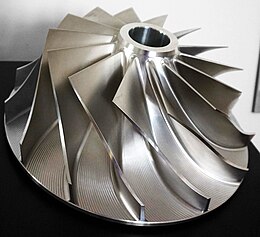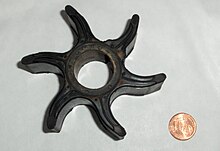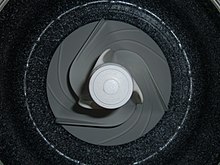Impeller

Animpeller,orimpellor,[1]is a drivenrotorused to increase the pressure and flow of a fluid. It is the opposite of aturbine,which extracts energy from, and reduces the pressure of, a flowing fluid.
Strictly speaking,propellersare a sub-class of impellers where the flow both enters and leaves axially, but in many contexts the term "impeller" is reserved fornon-propeller rotors where the flow enters axially and leaves radially, especially when creatingsuctionin apumporcompressor.
In pumps[edit]


An impeller is a rotating component of acentrifugal pumpthat accelerates fluid outward from the center of rotation, thus transferringenergyfrom themotorthat drives the pump to thefluidbeing pumped.[2][3]The velocity achieved by the impeller transfers into pressure when the outward movement of the fluid is confined by the pump casing. An impeller is usually a short cylinder with an open inlet (called an eye) to accept incoming fluid, vanes to push thefluidradially, and asplined,keyed,or threaded bore to accept a drive shaft.
It can be cheaper tocastan impeller and its spindle as one piece, rather than separately. This combination is sometimes referred to simply as the "rotor."
Types[edit]
Open[edit]
An open impeller has a hub with attached vanes and is mounted on a shaft. The vanes do not have a wall, making open impellers slightly weaker than closed or semi-closed impellers. However, as the side plate is not fixed to the inlet side of the vane, the blade stresses are significantly lower.[4]In pumps, the fluid enters the impeller's eye, where vanes add energy and direct it to the nozzle discharge. A closeclearancebetween vanes and pump volute or back plate prevent most of fluid from flowing back. Wear on the bowl and edge of vane can be compensated by adjusting the clearance to maintain efficiency over time.[5]Because the internal parts are visible, open impellers are easier to inspect for damage and maintain than closed impellers. They can also be more easily modified to change flow properties. Open impellers operate on a narrow range ofspecific speed.Open impellers are usually faster and easier to maintain. For small pumps and those dealing with suspended solids, open impellers are generally used.[6]Sand locking does not occur as easily as with closed type.
Semi-closed[edit]
A semi-closed impeller has an additional back wall, giving it more strength. These impellers can pass mixed solid-liquid mixtures at the cost of reduced efficiency.
Closed or shrouded[edit]
The construction of closed impellers includes additional back and front walls on both sides of vanes that enhances its strength. This also reduces thethrust loadon the shaft, increasing bearing life and reliability and reducing shafting cost. However, this more complicated design, including the use of additional wear rings, makes closed impellers more difficult to manufacture and more expensive than open impellers. A closed impeller's efficiency decreases as wear ring clearance increases with use. However, adjustment of impeller bowl clearance does not affect the wear on vanes as critically as open impeller.[4]Closed impellers can be used on a wider range specific speed than open impellers.[5]They are generally used in large pumps and clear water applications. These impellers can't perform effectively with solids and become difficult to clean if clogged.[6]
Screw[edit]
The screw impeller design aligns more with an axial progressive channel that allows for solids to be openly handled when rotating.[7][8]
In centrifugal compressors[edit]
The main part of acentrifugal compressoris the impeller. An open impeller has no cover, therefore it can work at higher speeds. A compressor with a covered impeller can have more stages than one that has an open impeller.
In water jets[edit]
Some impellers are similar to smallpropellersbut without the large blades. Among other uses, they are used inwater jetsto power high speed boats.
Because impellers do not have large blades to turn, they can spin at much higher speeds than propellers. The water forced through the impeller is channeled by the housing, creating a water jet that propels the vessel forward. The housing is normally tapered into a nozzle to increase the speed of the water, which also creates aVenturi effectin which low pressure behind the impeller pulls more water towards the blades, tending to increase the speed.
To work efficiently, there must be a close fit between the impeller and the housing. The housing is normally fitted with a replaceablewear ringwhich tends to wear assandor other particles are thrown against the housing side by the impeller.
Vessels using impellers are normally steered by changing the direction of the water jet.
Compare topropellerandjet aircraft engines.
In agitated tanks[edit]

Impellers in agitated tanks are used to mix fluids or slurry in the tank. This can be used to combine materials in the form of solids, liquids and gas. Mixing the fluids in a tank is very important if there aregradientsin conditions such as temperature or concentration.
There are two types of impellers, depending on the flow regime created (see figure):
- Axial flow impeller
- Radial flow impeller
Radial flow impellers impose essentiallyshear stressto the fluid, and are used, for example, to mix immiscible liquids or in general when there is a deformableinterfaceto break. Another application of radial flow impellers is the mixing of very viscous fluids.
Axial flow impellers impose essentially bulk motion and are used on homogenization processes, in which increased fluidvolumetric flow rateis important.
Impellers can be further classified principally into three sub-types:
Propellers[edit]
Propellers are axial thrust-giving elements. These elements give a very high degree of swirling in the vessel. The flow pattern generated in the fluid resembles a helix.
In washing machines[edit]

Some constructions of top loadingwashing machinesuse impellers toagitatethe laundry during washing.
Firefighting rank badge[edit]
Fire servicesin theUnited Kingdomand many countries of theCommonwealthuse a stylized depiction of an impeller as a rank badge. Officers wear one or more on theirepaulettesor the collar of their firefighting uniform as an equivalent to the "pips" worn by thearmyandpolice.
In air pumps[edit]
Air pumps, such as theroots blower,use meshing impellers to move air through a system. Applications include blast furnaces, ventilation systems, and superchargers for internal combustion engines.
In medicine[edit]
Impellers are an integral part ofaxial-flow pumps,used inventricular assist devicesto augment or fully replace cardiac function.[9][10]
See also[edit]
References[edit]
- ^"impeller, n.". OED Online. March 2013. Oxford University Press. 20 March 2013[1].
- ^Gülich, Johann Friedrich (2010).Centrifugal Pumps(2nd ed.).ISBN978-3-642-12823-3.
- ^Manuals, Seloc Marine (2008).Volvo Penta Stern Drives 2003-2012: Gasoline Engines & Drive Systems (Seloc Marine Manuals.Seloc Publishing.ISBN978-0893300746.
- ^ab"Pump Design and Characteristic".The New Zealand Digital Library.
- ^ab"Open vs. closed impellers – Mc Nally Institute".mcnallyinstitute.
- ^ab"Open and Closed Impellers".Turbomachineary International.
- ^"Types of Impeller in Pumps - Selections and Considerations".30 January 2021.
- ^Lin, Peng; Liu, Meiqing; Zhao, Wensheng; Liu, Zhiyong; Wu, Yuanwei; Xue, Fei; Zhang, Yipeng (2017)."Influence of tip clearance on the performance of a screw axial-flow pump".Advances in Mechanical Engineering.9(6).doi:10.1177/1687814017704357.S2CID117627953.
- ^Miller, LW; Pagani, FD (2007)."Use of a continuous-flow device in patients awaiting heart transplantation".N Engl J Med.357(9): 885–96.doi:10.1056/nejmoa067758.PMID17761592.
- ^Chou, N. K.; Wang, S. S.; Chu, S. H.; Chen, Y. S.; Lin, Y. H.; Chang, C. J.; Shyu, J. J.; Jan, G. J. (2001). "Physiologic analysis of cardiac cycle in an implantable impeller centrifugal left ventricular assist device".Artificial Organs.25(8): 613–6.doi:10.1046/j.1525-1594.2001.025008613.x.PMID11531711.
